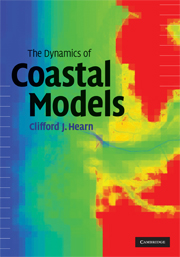Book contents
- Frontmatter
- Contents
- Preface
- Acknowledgements
- Note on mathematics and model codes
- 1 Prelude to modeling coastal basins
- 2 Currents and continuity
- 3 Box and one-dimensional models
- 4 Basic hydrodynamics
- 5 Simple hydrodynamic models
- 6 Modeling tides and long waves in coastal basins
- 7 Mixing in coastal basins
- 8 Advection of momentum
- 9 Aspects of stratification
- 10 Dynamics of partially mixed basins
- 11 Roughness in coastal basins
- 12 Wave and sediment dynamics
- References
- Index
- References
12 - Wave and sediment dynamics
Published online by Cambridge University Press: 18 December 2009
- Frontmatter
- Contents
- Preface
- Acknowledgements
- Note on mathematics and model codes
- 1 Prelude to modeling coastal basins
- 2 Currents and continuity
- 3 Box and one-dimensional models
- 4 Basic hydrodynamics
- 5 Simple hydrodynamic models
- 6 Modeling tides and long waves in coastal basins
- 7 Mixing in coastal basins
- 8 Advection of momentum
- 9 Aspects of stratification
- 10 Dynamics of partially mixed basins
- 11 Roughness in coastal basins
- 12 Wave and sediment dynamics
- References
- Index
- References
Summary
Introduction
In this chapter, we briefly consider available wave models for coastal basins and the physical conditions which lead to the erosion, transport, and deposition of sediment. Sediments are moved about more in shallow water than in the deep sea, because surface waves can affect the seabed, and tidal currents are typically stronger than in the open ocean, because of increased tidal ranges. Sediment transport and deposition are also more easily studied in shallow water, but the principles governing these processes are as valid in the deep ocean as they are in an estuary, beach, or anywhere there is moving water.
Wave models
Wave modeling in coastal basins is a highly developed tool necessary for both studies of sediment transport and nearshore processes including coastal engineering. As with hydrodynamic models, wave models can be run in both hindcast, nowcast, and forecast modes. Our interest within this chapter is directed towards the use of wave models in sediment transport within coastal basins. The study of all of the techniques of wave modeling is outside our present scope and establishing a wave model for a particular coastal basin requires not only skill, and a proper assessment of the type of predictions that are required from such a model, but also very good data sets to drive, calibrate and verify the model. As a generalization, wave models tend to be much more dependent on good data than are hydrodynamic models since they tend to contain more adjustable parameters.
- Type
- Chapter
- Information
- The Dynamics of Coastal Models , pp. 436 - 470Publisher: Cambridge University PressPrint publication year: 2008



